engine TOYOTA YARIS HATCHBACK 2020 Owners Manual (in English)
[x] Cancel search | Manufacturer: TOYOTA, Model Year: 2020, Model line: YARIS HATCHBACK, Model: TOYOTA YARIS HATCHBACK 2020Pages: 572, PDF Size: 7.94 MB
Page 449 of 572
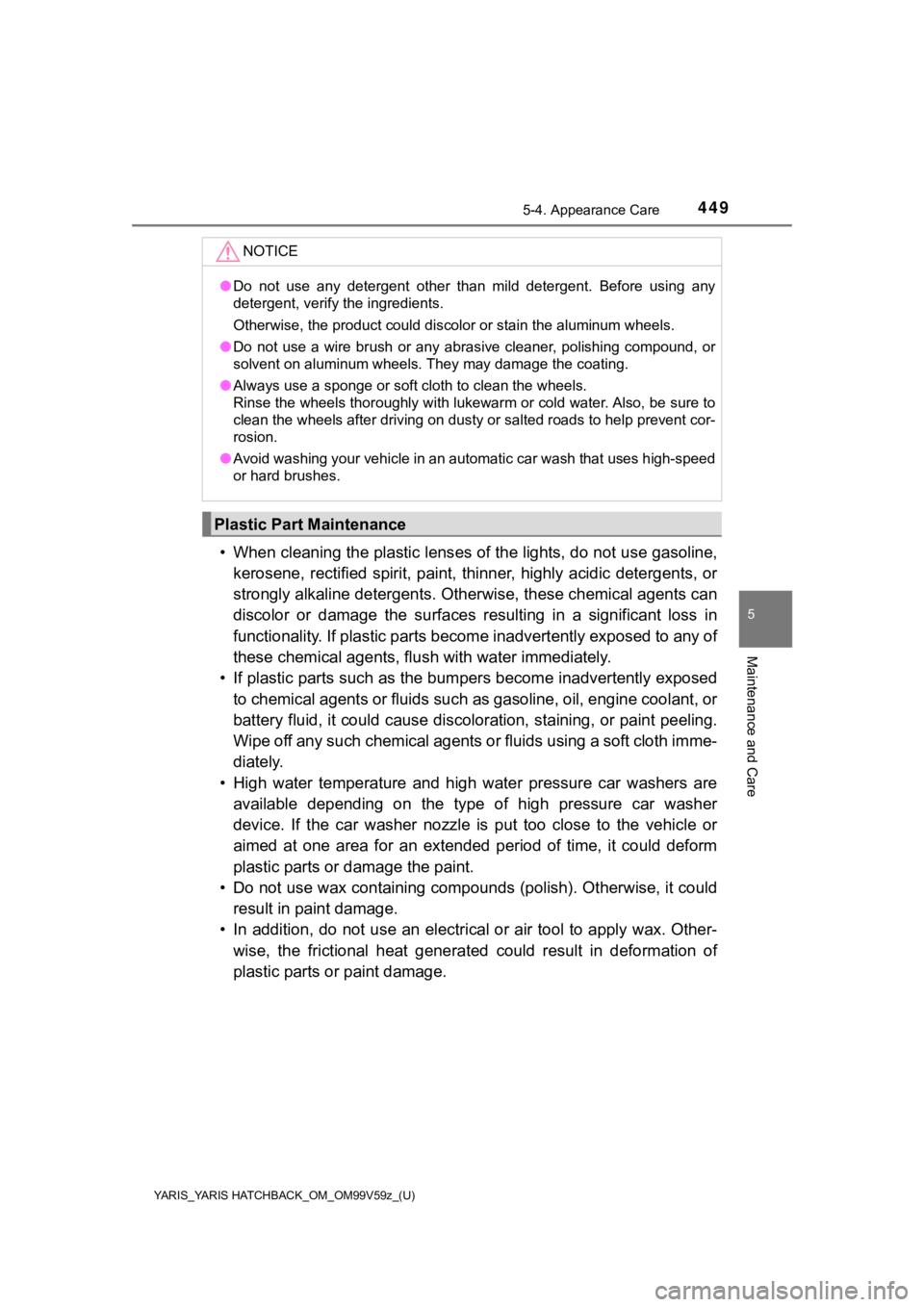
YARIS_YARIS HATCHBACK_OM_OM99V59z_(U)
4495-4. Appearance Care
5
Maintenance and Care
• When cleaning the plastic lenses of the lights, do not use gasoline,
kerosene, rectified spirit, paint, thinner, highly acidic deter gents, or
strongly alkaline detergents. Ot herwise, these chemical agents can
discolor or damage the surfaces resulting in a significant loss in
functionality. If plastic parts become inadvertently exposed to any of
these chemical age nts, flush with water immediately.
• If plastic parts such as the bumpers become inadvertently exposed to chemical agents or fluids such as gasoline, oil, engine cool ant, or
battery fluid, it could cause di scoloration, staining, or paint peeling.
Wipe off any such chemical agents or fluids using a soft cloth imme-
diately.
• High water temperature and high water pressure car washers are available depending on the type of high pressure car washer
device. If the car washer nozzle is put too close to the vehicl e or
aimed at one area for an extended period of time, it could defo rm
plastic parts or damage the paint.
• Do not use wax containing compounds (polish). Otherwise, it co uld
result in paint damage.
• In addition, do not use an electrical or air tool to apply wax . Other-
wise, the frictional heat generat ed could result in deformation of
plastic parts o r paint damage.
NOTICE
●Do not use any detergent other than mild detergent. Before usin g any
detergent, verify the ingredients.
Otherwise, the product could discolor or stain the aluminum whe els.
● Do not use a wire brush or any abrasive cleaner, polishing comp ound, or
solvent on aluminum wheels. They may damage the coating.
● Always use a sponge or soft cloth to clean the wheels.
Rinse the wheels thoroughly with lukewarm or cold water. Also, be sure to
clean the wheels after driving on dusty or salted roads to help prevent cor-
rosion.
● Avoid washing your vehicle in an automatic car wash that uses h igh-speed
or hard brushes.
Plastic Part Maintenance
Page 455 of 572

455
YARIS_YARIS HATCHBACK_OM_OM99V59z_(U)
6If Trouble Arises
6-1. Parking in an EmergencyParking in an Emergency ...................... 456
6-2. Flat Tire Spare Tire and Tool Storage ........................... 457
Changing a Flat Tire ......... 463
6-3. Battery Runs Out Jump-Starting.................... 478
6-4. Emergency Starting Starting a Flooded Engine............................. 482
Push-Starting .................... 483
6-5. Overheating Overheating ...................... 484
6-6. Emergency Towing Towing Description ........... 486
Tiedown Hooks ................. 487
6-7. Warning/Indicator Lights and Warning Sounds
If a Warning Light Turns On or Flashes ................. 489
Message Indicated on Display ............................ 500
Warning Sound is Activated ......................... 502
6-8. When Trunk Lid Cannot be Opened
When Liftgate/Trunk Lid Cannot be Opened ......... 506
Page 463 of 572
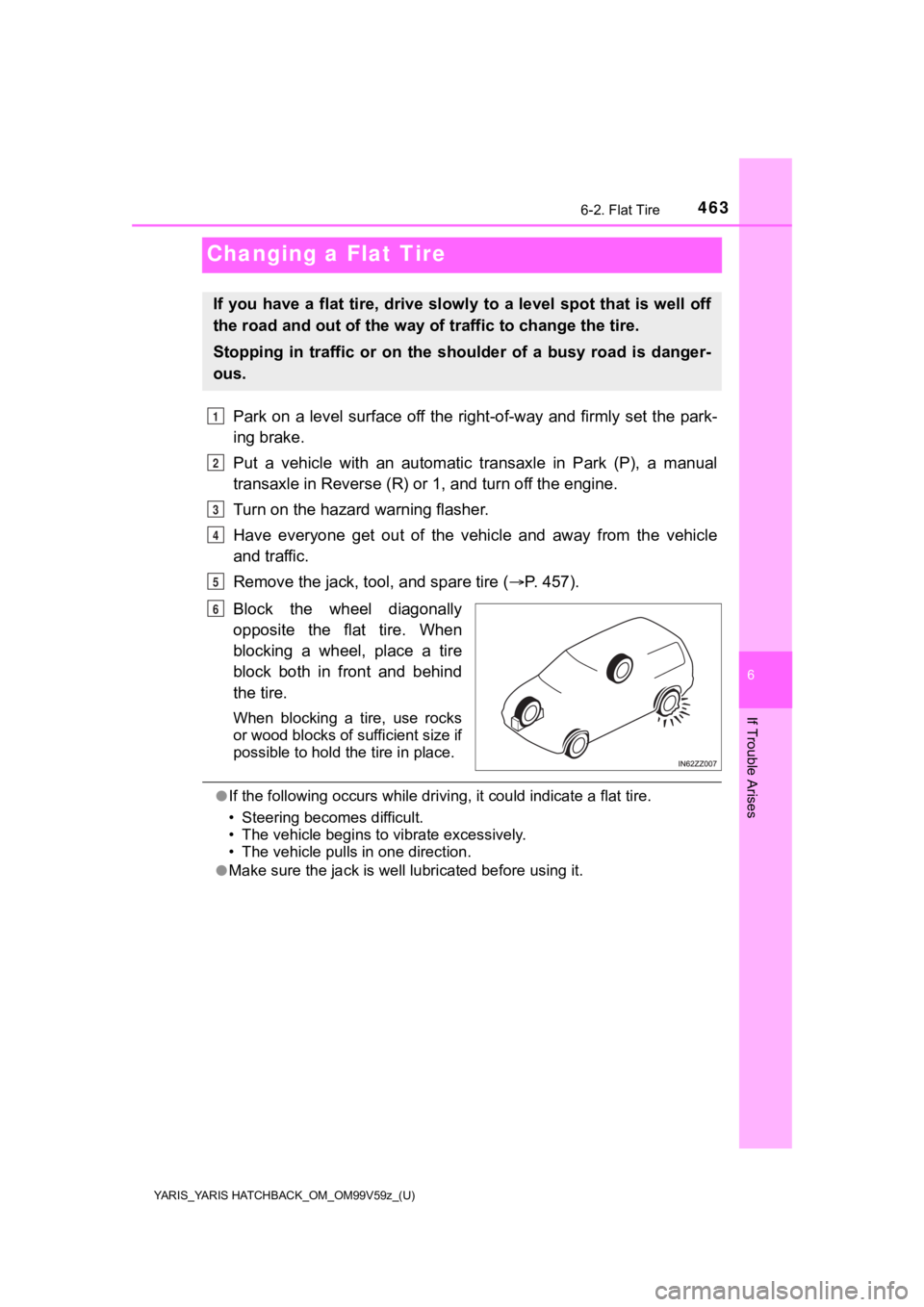
463
YARIS_YARIS HATCHBACK_OM_OM99V59z_(U)
6-2. Flat Tire
6
If Trouble Arises
Changing a Flat Tire
Park on a level surface off the right-of-way and firmly set the park-
ing brake.
Put a vehicle with an automatic transaxle in Park (P), a manual
transaxle in Reverse (R) or 1, and turn off the engine.
Turn on the hazard warning flasher.
Have everyone get out of the vehicle and away from the vehicle
and traffic.
Remove the jack, tool, and spare tire ( P. 457).
Block the wheel diagonally
opposite the flat tire. When
blocking a wheel, place a tire
block both in front and behind
the tire.
When blocking a tire, use rocks
or wood blocks of sufficient size if
possible to hold the tire in place.
●If the following occurs while dri ving, it could indicate a flat tire.
• Steering becomes difficult.
• The vehicle begins to vibrate excessively.
• The vehicle pulls in one direction.
●Make sure the jack is well lu bricated before using it.
If you have a flat tire, drive slowly to a level spot that is w ell off
the road and out of the way of traffic to change the tire.
Stopping in traffic or on the shoulder of a busy road is danger-
ous.
1
2
3
4
5
6
Page 467 of 572

YARIS_YARIS HATCHBACK_OM_OM99V59z_(U)
4676-2. Flat Tire
6
If Trouble Arises
WARNING
■When jacking-up a vehicle, always shift the shift lever to 1st or R
position (manual transaxle vehicle) or shift the selector lever to P
position (automatic transaxle vehicle), apply the parking brake , and
place wheel blocks in the position diagonally opposed to the ja ck
Changing a flat tire without using wheel blocks is dangerous be cause
the vehicle may move and fall of f the jack even with the shift lever in 1st
or R position, or the selector l ever is in P position, which co uld result in
an accident.
■Use only the front and rear jacking positions recommended in th is
manual
Attempting to jack the vehicle in positions other than those recom-
mended in this manual is dangerous. The vehicle could slip off the jack
and seriously injure or even kill someone. Use only the front and rear
jacking positions recommended in this manual.
■Do not jack up the vehicle in a position other than the designa ted
jack-up position or place any objects on or under the jack
Jacking up the vehicle in a position other than the designated jack-up
position or placing objects on or under the jack is dangerous a s it could
deform the vehicle body or the vehicle could fall off the jack resulting in
an accident.
■Use only the jack provi ded with your Toyota
Using a jack that is not designe d for your Toyota is dangerous. The vehi-
cle could slip off the jack and seriously injure someone.
■Never place objects under the jack
Jacking the vehicle with an objec t under the jack is dangerous. The jack
could slip and someone could be seriously injured by the jack o r the fall-
ing vehicle.
■Do not jack up the vehicle higher than is necessary
Jacking up the vehicle higher than is necessary is dangerous as it could
destabilize the vehicle resulting in an accident.
■Do not start the engine or shake the vehicle while it is jacked up
Starting the engine or shaking the vehicle while it is jacked u p is danger-
ous as it could cause the vehicle to fall off the jack resulting in an acci-
dent.
■Never go under the vehicl e while it is jacked up
Going under the vehicle while it is jacked up is dangerous as i t could
result in death or serious injur y if the vehicle were to fall off the jack.
Damage could occur during installation if the wheel cover is no t properly
aligned.
Page 479 of 572
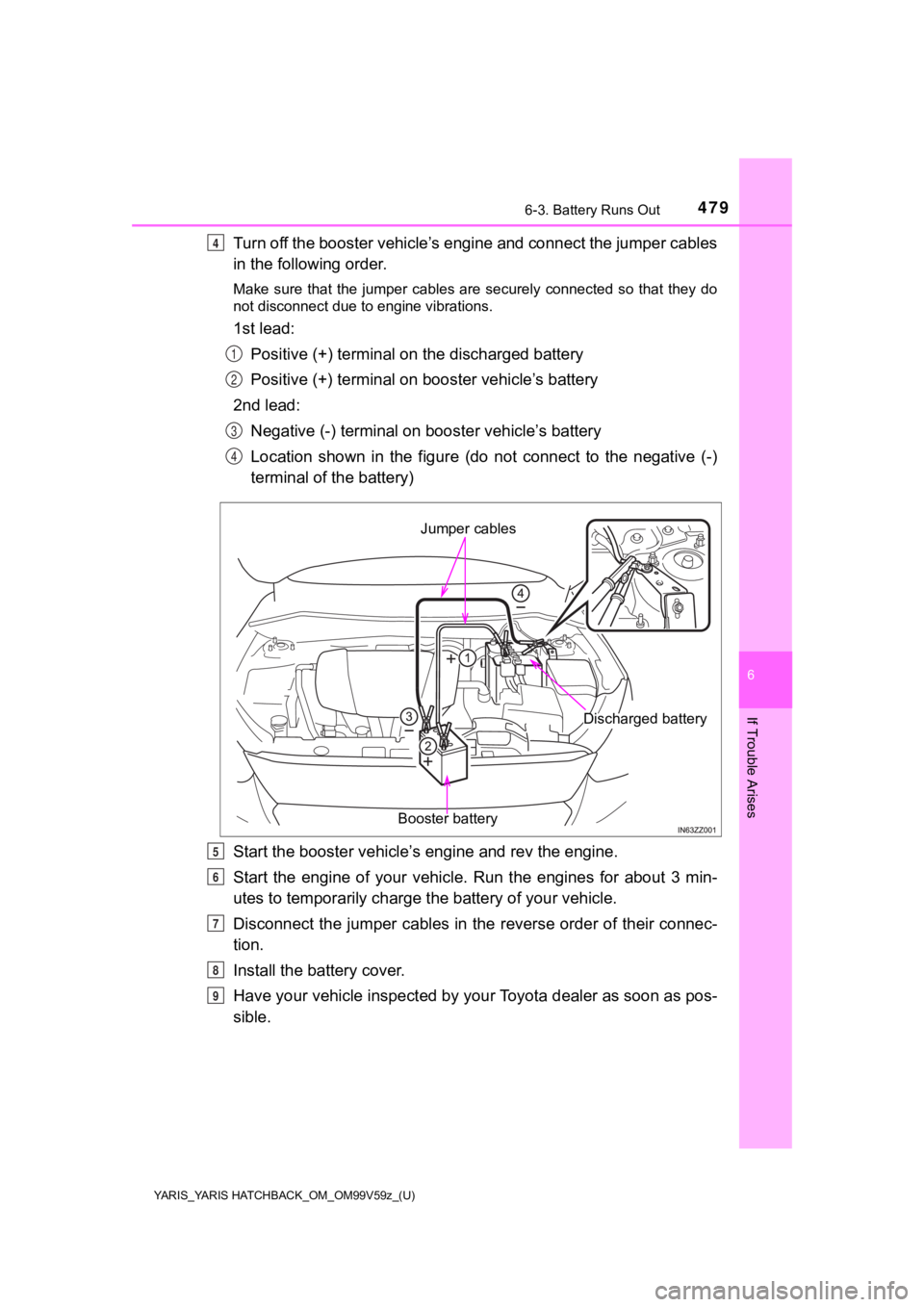
YARIS_YARIS HATCHBACK_OM_OM99V59z_(U)
4796-3. Battery Runs Out
6
If Trouble Arises
Turn off the booster vehicle’s engine and connect the jumper cables
in the following order.
Make sure that the jumper cables are securely connected so that they do
not disconnect due to engine vibrations.
1st lead:
Positive (+) terminal on the discharged battery
Positive (+) terminal on booster vehicle’s battery
2nd lead: Negative (-) terminal on boo ster vehicle’s battery
Location shown in the figure (do not connect to the negative (- )
terminal of the battery)
Start the booster vehicle’ s engine and rev the engine.
Start the engine of your vehicle. Run the engines for about 3 min-
utes to temporarily charge th e battery of your vehicle.
Disconnect the jumper cables in the reverse order of their conn ec-
tion.
Install the battery cover.
Have your vehicle inspected by y our Toyota dealer as soon as pos-
sible.
4
1
2
3
4
Jumper cables
Booster battery
Discharged battery
5
6
7
8
9
Page 480 of 572
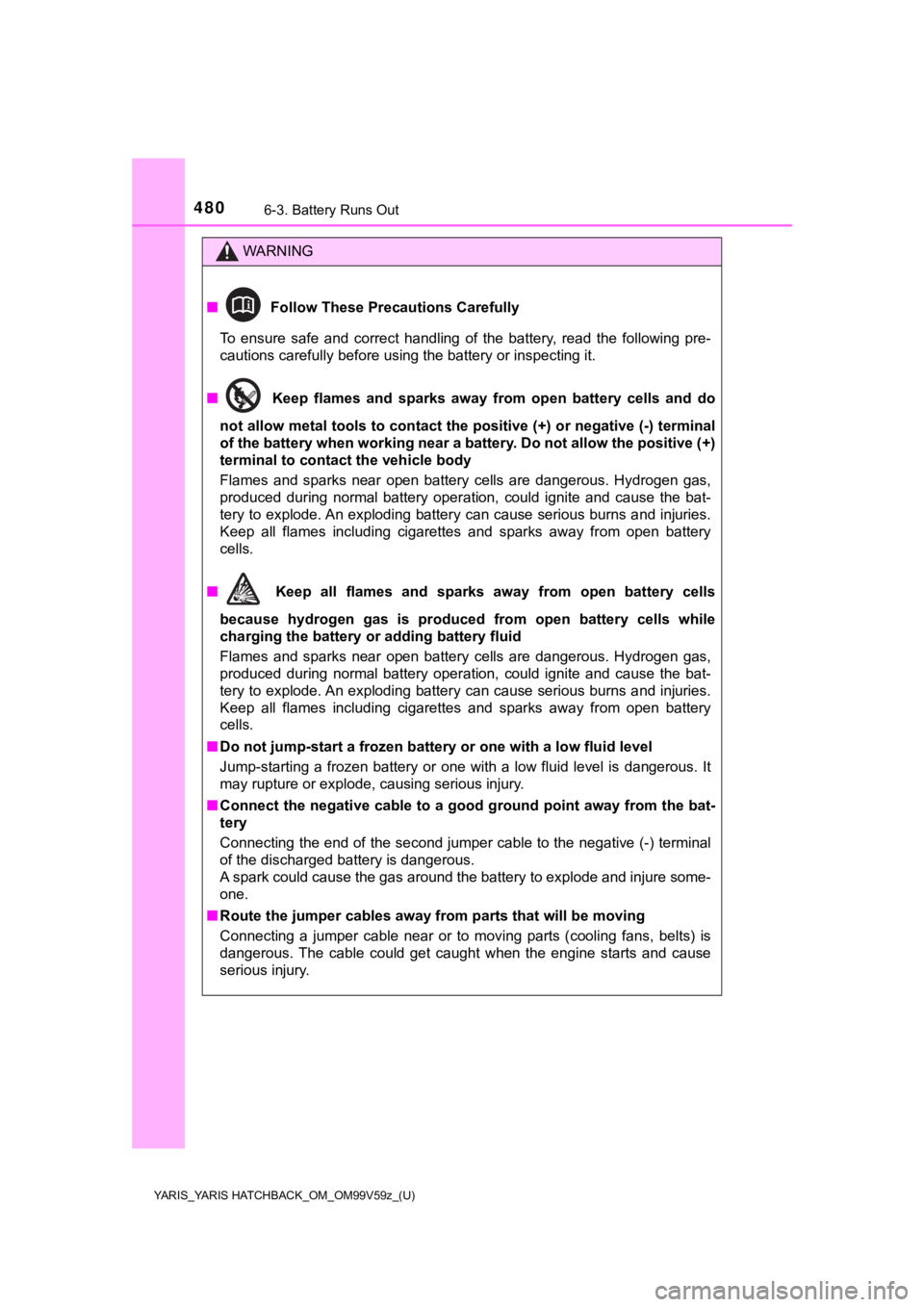
4806-3. Battery Runs Out
YARIS_YARIS HATCHBACK_OM_OM99V59z_(U)
WARNING
■ Follow These Precautions Carefully
To ensure safe and correct handling of the battery, read the fo llowing pre-
cautions carefully before using the battery or inspecting it.
■ Keep flames and sparks away from open battery cells and do
not allow metal tools to contact the positive (+) or negative ( -) terminal
of the battery when working near a battery. Do not allow the positive (+)
terminal to contact the vehicle body
Flames and sparks near open battery cells are dangerous. Hydrog en gas,
produced during normal battery operation, could ignite and cause the bat-
tery to explode. An exploding battery can cause serious burns a nd injuries.
Keep all flames including cigarettes and sparks away from open battery
cells.
■ Keep all flames and sparks away from open battery cells
because hydrogen gas is produced from open battery cells while
charging the battery or adding battery fluid
Flames and sparks near open battery cells are dangerous. Hydrog en gas,
produced during normal battery operation, could ignite and cause the bat-
tery to explode. An exploding battery can cause serious burns a nd injuries.
Keep all flames including cigarettes and sparks away from open battery
cells.
■ Do not jump-start a frozen bat tery or one with a low fluid leve l
Jump-starting a frozen battery or one with a low fluid level is dangerous. It
may rupture or explode, causing serious injury.
■ Connect the negative cable to a good ground point away from the bat-
tery
Connecting the end of the second jumper cable to the negative ( -) terminal
of the discharged battery is dangerous.
A spark could cause the gas around the battery to explode and i njure some-
one.
■ Route the jumper cables away from parts that will be moving
Connecting a jumper cable near or to moving parts (cooling fans, belts) is
dangerous. The cable could get caught when the engine starts an d cause
serious injury.
Page 482 of 572

482
YARIS_YARIS HATCHBACK_OM_OM99V59z_(U)
6-4. Emergency Starting
Starting a Flooded Engine
Follow this procedure:If the engine does not start within 5 seconds on the first try, wait 10
seconds and try again.
Make sure the parking brake is on.
Depress the accelerator all the way and hold it there.
Depress the clutch pedal (Manual transaxle) or the brake pedal
(Automatic transaxle), then press the push button start. If the
engine starts, release the accele rator immediately because the
engine will sud denly rev up.
If the engine fails to start, cra nk it without depressing the a ccelera-
tor.
If the engine still does not start using the above procedure, h ave your
vehicle inspected by your Toyota dealer.
If the engine fails to start, it may be flooded (excessive fuel in
the engine).
1
2
3
4
5
Page 483 of 572

483
YARIS_YARIS HATCHBACK_OM_OM99V59z_(U)
6-4. Emergency Starting
6
If Trouble Arises
Push-Starting
Do not push-start your Toyota.
You cannot start a vehicle with an automatic transaxle by pushing it.
WARNING
■Never tow a vehicle to start it
Towing a vehicle to start it is dangerous. The vehicle being to wed could
surge forward when its engine starts, causing the 2 vehicles to collide. The
occupants could be injured.
NOTICE
Do not push-start a vehicle that has a manual transaxle. It can damage the
emission control system.
Page 484 of 572
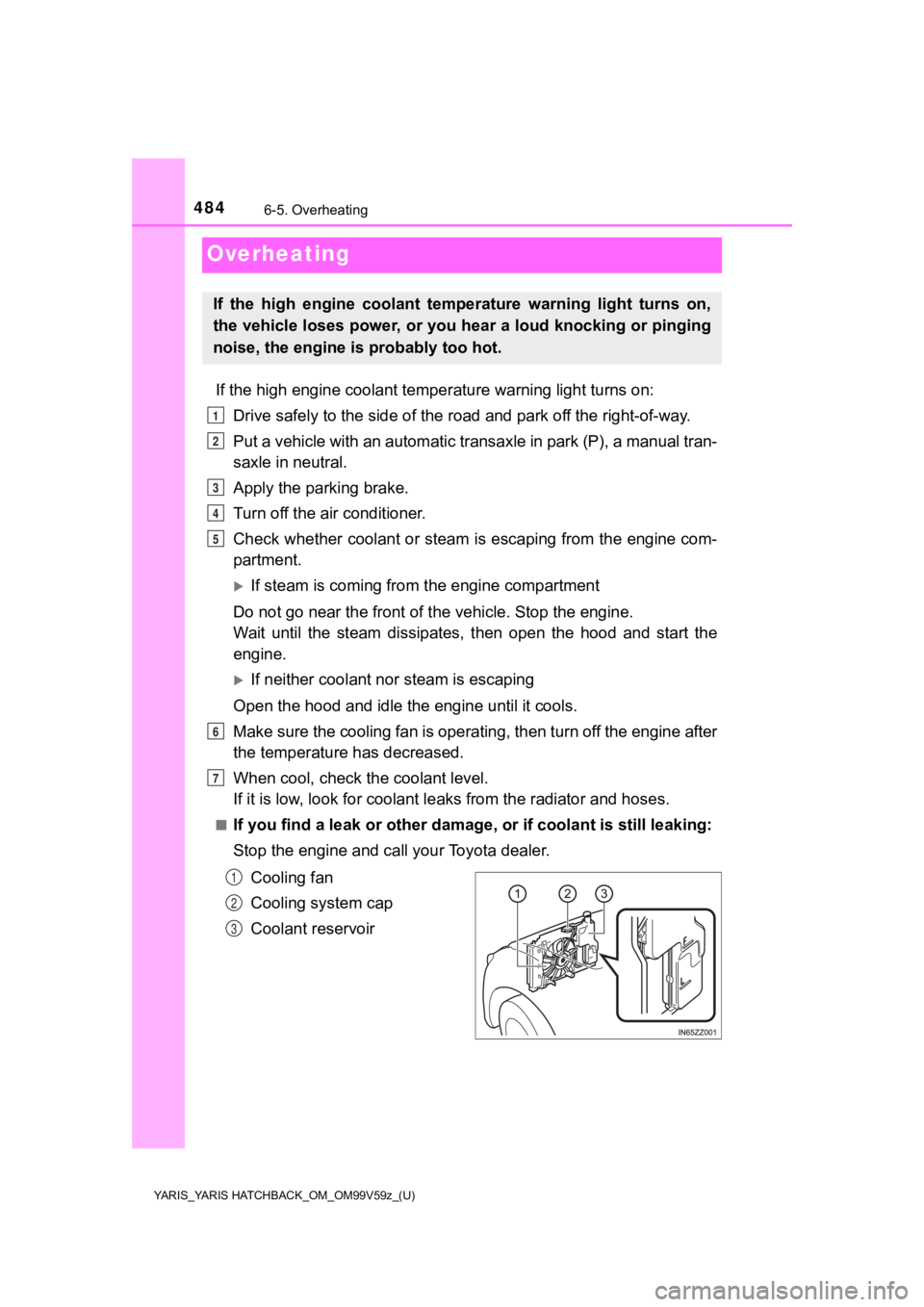
484
YARIS_YARIS HATCHBACK_OM_OM99V59z_(U)
6-5. Overheating
Overheating
If the high engine coolant temperature warning light turns on:
Drive safely to the side of the road and park off the right-of-way.
Put a vehicle with an automatic t ransaxle in park (P), a manual tran-
saxle in neutral.
Apply the parking brake.
Turn off the air conditioner.
Check whether coolant or steam is escaping from the engine com-
partment.
If steam is coming from the engine compartment
Do not go near the front of t he vehicle. Stop the engine.
Wait until the steam dissipates, then open the hood and start the
engine.
If neither coolant nor steam is escaping
Open the hood and idle the engine until it cools.
Make sure the cooling fan is operating, then turn off the engin e after
the temperature has decreased.
When cool, check th e coolant level.
If it is low, look for coolant lea ks from the radiator and hoses.
■If you find a leak or other damage, or if coolant is still leak ing:
Stop the engine and call your Toyota dealer.
Cooling fan
Cooling system cap
Coolant reservoir
If the high engine coolant temperature warning light turns on,
the vehicle loses power, or you hear a loud knocking or pinging
noise, the engine is probably too hot.
1
2
3
4
5
6
7
1
2
3
Page 485 of 572
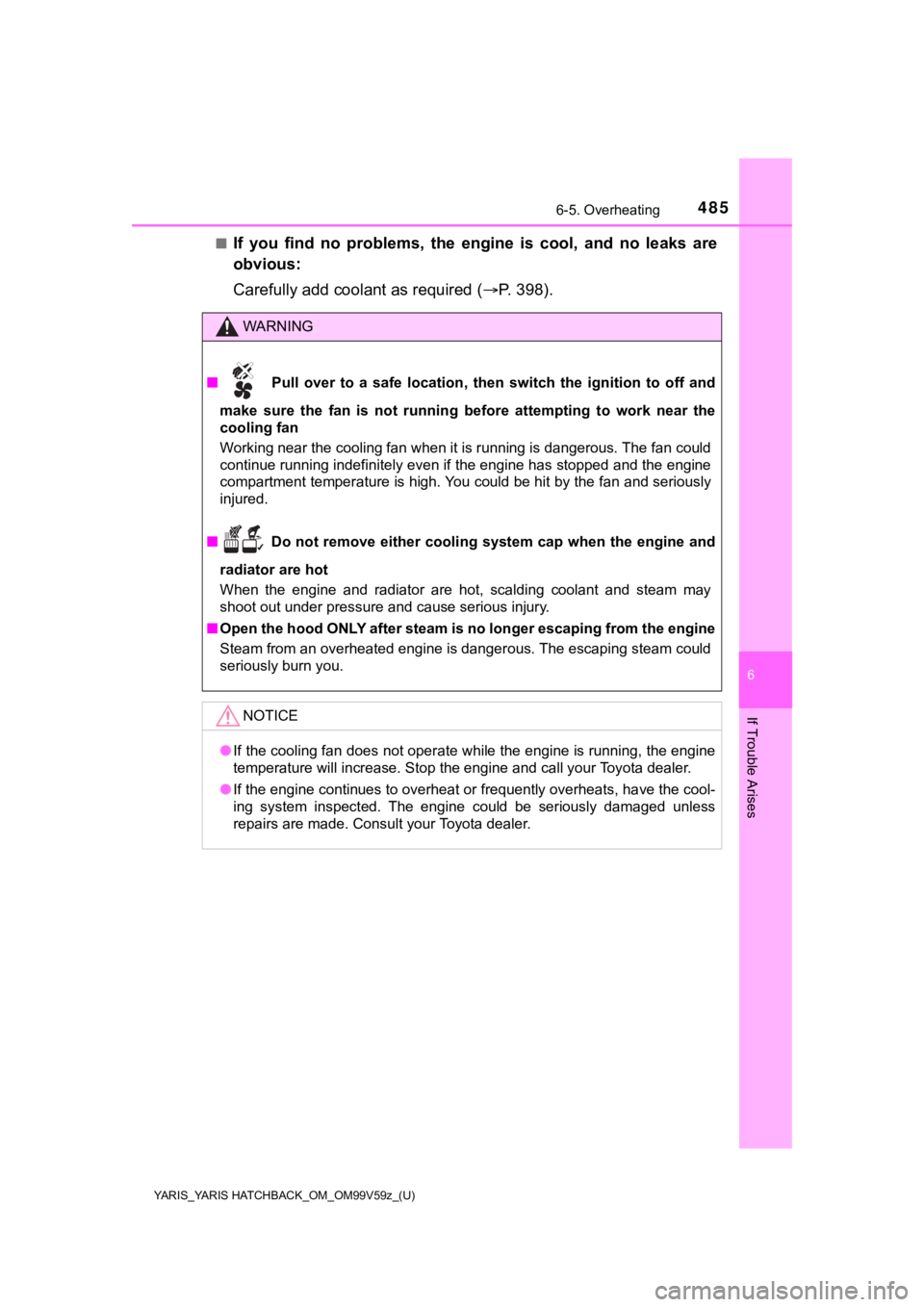
YARIS_YARIS HATCHBACK_OM_OM99V59z_(U)
4856-5. Overheating
6
If Trouble Arises
■If you find no problems, the engine is cool, and no leaks are
obvious:
Carefully add coolant as required (P. 398).
WARNING
■ Pull over to a safe location, then switch the ignition to off and
make sure the fan is not running before attempting to work near the
cooling fan
Working near the cooling fan when it is running is dangerous. T he fan could
continue running indefinitely even if the engine has stopped an d the engine
compartment temperature is high. You could be hit by the fan an d seriously
injured.
■ Do not remove either cooling system cap when the engine and
radiator are hot
When the engine and radiator are hot, scalding coolant and steam may
shoot out under pressure and cause serious injury.
■ Open the hood ONLY after steam is no longer escaping from the e ngine
Steam from an overheated engine is dangerous. The escaping stea m could
seriously burn you.
NOTICE
● If the cooling fan does not operate while the engine is running, the engine
temperature will increase. Stop the engine and call your Toyota dealer.
● If the engine continues to overheat or frequently overheats, ha ve the cool-
ing system inspected. The engine could be seriously damaged unl ess
repairs are made. Consult your Toyota dealer.